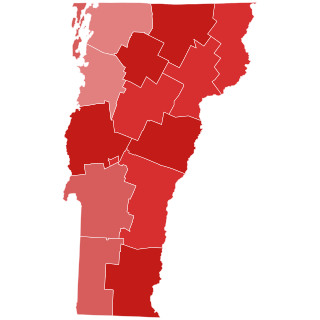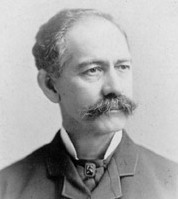
The 1952 Vermont gubernatorial election took place on November 4, 1952. Incumbent Republican Lee E. Emerson ran successfully for re-election to a second term as Governor of Vermont, defeating Democratic candidate Robert W. Larrow and write-in candidate Henry D. Vail.

The 1946 Vermont gubernatorial election took place on November 5, 1946. Incumbent Republican Mortimer R. Proctor ran unsuccessfully for re-election to a second term as Governor of Vermont, losing to Ernest W. Gibson, Jr. in the Republican primary. Gibson defeated Democratic candidate Berthold C. Coburn in the general election.

The 1944 Vermont gubernatorial election took place on November 7, 1944. Incumbent Republican William H. Wills did not run for re-election to a third term as Governor of Vermont. Republican candidate Mortimer R. Proctor defeated Democratic candidate Ernest H. Bailey to succeed him.

The 1940 Vermont gubernatorial election took place on November 5, 1940. Incumbent Republican George Aiken did not run for re-election to a third term as Governor of Vermont, instead running for the United States Senate. Republican candidate William H. Wills defeated Democratic candidate John McGrath to succeed him.

The 1938 Vermont gubernatorial election took place on November 8, 1938. Incumbent Republican George Aiken ran successfully for re-election to a second term as Governor of Vermont, defeating Democratic candidate Fred C. Martin.

The 1936 Vermont gubernatorial election took place on November 3, 1936. Incumbent Republican Charles M. Smith did not run for re-election to a second term as Governor of Vermont. Republican candidate George Aiken defeated Democratic candidate Alfred H. Heininger to succeed him.

The 1934 Vermont gubernatorial election took place on November 6, 1934. Incumbent Republican Stanley C. Wilson did not run for re-election to a third term as Governor of Vermont. Republican candidate Charles M. Smith defeated Democratic candidate James P. Leamy to succeed him.

The 1930 Vermont gubernatorial election took place on November 4, 1930. Incumbent Republican John E. Weeks did not run for re-election to a third term as Governor of Vermont. Republican candidate Stanley C. Wilson defeated Democratic candidate Park H. Pollard to succeed him.

The 1928 Vermont gubernatorial election took place on November 6, 1928. Incumbent Republican John E. Weeks ran successfully for re-election to a second term as Governor of Vermont, defeating Democratic candidate Harry C. Shurtleff, an attorney. Weeks, who sought an exception to the Vermont Republican Party's "Mountain Rule", was the first Vermont Governor elected to a second two-year term.

The 1924 Vermont gubernatorial election took place on November 4, 1924. Incumbent Republican Redfield Proctor Jr., per the "Mountain Rule", did not run for re-election to a second term as Governor of Vermont. Republican candidate Franklin S. Billings defeated Democratic candidate Fred C. Martin to succeed him.

The 1920 Vermont gubernatorial election took place on November 2, 1920. Incumbent Republican Percival W. Clement, per the "Mountain Rule", did not run for re-election to a second term as Governor of Vermont. Republican candidate James Hartness defeated Democratic candidate Fred C. Martin to succeed him.

The 1918 Vermont gubernatorial election took place on November 5, 1918. Incumbent Republican Horace F. Graham, per the "Mountain Rule", did not run for re-election to a second term as Governor of Vermont. Republican candidate Percival W. Clement defeated Democratic candidate William B. Mayo to succeed him.

The 1916 Vermont gubernatorial election took place on November 7, 1916. Incumbent Republican Charles W. Gates, per the "Mountain Rule", did not run for re-election to a second term as Governor of Vermont. Republican candidate Horace F. Graham defeated Democratic candidate William B. Mayo to succeed him.

The 1908 Vermont gubernatorial election took place on September 1, 1908. Incumbent Republican Fletcher D. Proctor, per the "Mountain Rule", did not run for re-election to a second term as Governor of Vermont. Republican candidate George H. Prouty defeated Democratic candidate, Burlington mayor James Edmund Burke to succeed him.

The 1904 Vermont gubernatorial election took place on September 6, 1904. Incumbent Republican John G. McCullough, per the "Mountain Rule", did not run for re-election to a second term as Governor of Vermont. Republican candidate Charles J. Bell defeated Democratic candidate Eli H. Porter to succeed him.

The 1902 Vermont gubernatorial election took place on September 2, 1902. Incumbent Republican William W. Stickney, per the "Mountain Rule", did not run for re-election to a second term as Governor of Vermont. Republican candidate John G. McCullough defeated Local Option candidate Percival W. Clement and Democratic candidate Felix W. McGettrick to succeed him. Since no candidate won a majority of the popular vote, the election was decided and McCullough was elected by the Vermont General Assembly in accordance with the state constitution.

The 1900 Vermont gubernatorial election took place on September 4, 1900. Incumbent Republican Edward C. Smith, per the "Mountain Rule", did not run for re-election to a second term as Governor of Vermont. Republican candidate William W. Stickney defeated Democratic candidate John H. Senter to succeed him.

The 1923 United States Senate special election in Vermont took place on November 6, 1923. Republican Porter H. Dale was elected to the United States Senate to serve the remainder of the deceased William P. Dillingham's term, defeating Democratic candidate Park H. Pollard.

John Holmes Jackson was an American politician who served as the 24th and 26th Mayor of Burlington, Vermont. His initial narrow ten vote victory in 1917 against incumbent Albert S. Drew is the closest mayoral election in Burlington's history, although Clarence H. Beecher's 1927 victory was decreased from 89 votes to 8 votes by a Supreme Court ruling in 1929, and wasn't matched until Bernie Sanders won the 1981 mayoral election by ten votes after a recount.

Park H. Pollard was an American politician and businessman who served from 1912 to 1942 as chairman of the Democratic Party of Vermont, as well as several terms in the Vermont House of Representatives where he represented the town of Cavendish. He was the Democratic nominee for the U.S. Senate in 1923, and for Governor of Vermont in 1930 and 1942.



















